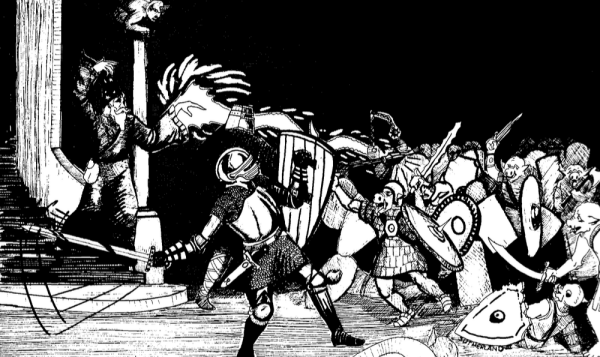Order of Battle: Retrospective
2023-02-07

As I said in my previous
post,
I hadn't read any old-school D&D modules for over a decade until this month. I
thought it would be educational to fly blind-ish for the start of our AD&D
campaign and see how I did things. Reading some modules (new and old) and
reviews these past few weeks, I noticed the idea of an order of battle come up a
bunch. Makes sense – write down what the location's denizens will do in
different cases, such as if the alarm is raised.
I decided to try this out immediately, applying the principle to an adventure
location I prepared for low-level characters who had one or two 3rd-6th level
characters to help them out. (Some players wanted new characters to earn some
experience after losing some characters before continuing exploration of riskier
locales.)
The PCs are still exploring the site in question, but there was a lengthy fight
to first secure the location from some brigands and other evil kinds. The PCs'
enemies were obviously spread out in different locations doing things when the
PCs arrived, not just waiting around to be attacked. But I had added notes to my
key indicating where each group or NPC would go if the alarm was raised.
Having now run the fight, I would do two things differently next time:
- I would indicate, directly on my map, the starting location and "alarmed
state" location of each enemy group. Scanning through the key for different
groups and determining whether they could get to X in Y rounds or hear Z from
Q was not practical. I should have prepared an easier reference. Justin
Alexander's adversary rosters can be good, but I think if there is a decent
chance battle will be joined by cohesive forces from many locations, you
might want that right on the map.
- I would have a list of total forces at the location by type, and tally them
off as they are defeated. Knowing the total numbers remaining in the scenario
could have allowed me to more easily judge and improv movements without worry
of fielding too many or too few numbers. Since I care about providing the
correct challenge and the correspondingly correct number of treasure rolls,
this would have been nice. Especially when the enemies had been given a
chance to regroup – I could have more easily judged how they'd rebalance
themselves in their fortification. I ended up making this total and tally
mid-session.
I had fun running the fight, and players dig a good siege, but the order of
battle I had written was basically ignored in favor of my best memory because I
made the written order unwieldy by spreading each group's orders across their
keyed starting areas. If you intend to prepare a scenario with defined
"unalarmed" and "alarmed" states, I recommend making a quick reference, probably
with map markings.
Two bonus points:
- An order of battle doesn't mean that the forces you prepare it for actually
have an orchestrated response in-game. In fact, most forces will probably act
in some measure of disarray. Highly-coordinated and drilled responses to
attack will likely be seen in only the most well-trained, prepared, veteran
forces. The order of battle is for the DM, and it might just tell the DM what
the forces' wild, untrained reaction will be to the PCs' raid. The DM will
already know how the forces will generally act, and can spend attention on
other things at the table.
- If this wasn't a scenario intended to be survivable for 1st level characters
(which was already quite dangerous), I would have provided more ways for the
defenders to take advantage of PCs plotting after forcing their enemies back
in the initial clash. In such a scenario, I would definitely want to include
some bullet points on how those actions relate to the order of battle. In
this particular fight, twelve brigands had time to hide and fire 24 arrows at
two characters in a single round. I think that is enough, considering a
single surprise segment would have given them 72 arrows, complete surprise
144 arrows. (Remember: missile fire is a special ability on the XP table for
a reason. How did they survive the double volley? Good armor, and the Weapon
vs AC table.)
← Go back home

